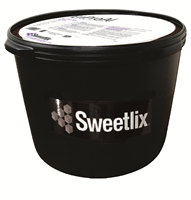


CAUTION: USE AS DIRECTED. Consumption of selenium should not exceed 3 mg per head daily for cattle or horses or exceed 0.7 mg per head daily for sheep, goats, llamas or other camelids.
Introductory Period: Following a 7 to 10 day acclimation period, average consumption should be 1 to 2 pounds for mature cattle or horses or 2 to 4 ounces for sheep or goats with unrestricted forage supplies. Position the blocks 50 to 75 feet from loafing, feeding and watering areas. Some re-positioning of blocks may be necessary as animals become acclimated to the presence of the blocks. Move blocks closer to increase consumption; further away to decrease consumption. If over consumption occurs for more than two weeks and re-positioning of blocks does not correct the situation, remove blocks and evaluate the overall feeding program. DO NOT ALLOW STARVED ANIMALS FREE ACCESS TO THIS BLOCK.
Feeding Recommendations:
| Crude Protein, Min | 12.00% |
| Crude Fat, Min | 3.00% |
| Crude Fiber, Max | 6.00% |
| Acid Detergent Fiber, Max | 3.00% |
| Neutral Detergent Fiber, Max | 7.00% |
| Calcium, Min | 0.50% |
| Calcium, Max | 1.00% |
| Phosphorus, Min | 0.50% |
| Salt, Min | 2.50% |
| Salt, Max | 3.50% |
| Magnesium, Min | 3.00% |
| Selenium, Min | 3.3 ppm |
| Zinc, Min | 360 ppm |
| Vitamin A, Min | 14,000 IU/lb |
Molasses Products, Plant Protein Products, Processed Grain By-Products, Magnesium Oxide, Salt, Hydrolyzed Vegetable Oil, Monocalcium Phosphate, Dicalcium Phosphate, Calcium Carbonate, Selenium Yeast, Ferrous Sulfate, Manganous Oxide, Zinc Oxide, Manganese Sulfate, Zinc Sulfate, Calcium Iodate, Cobalt Sulfate, Sodium Molybdate, Vitamin A Supplement and Mineral Oil.